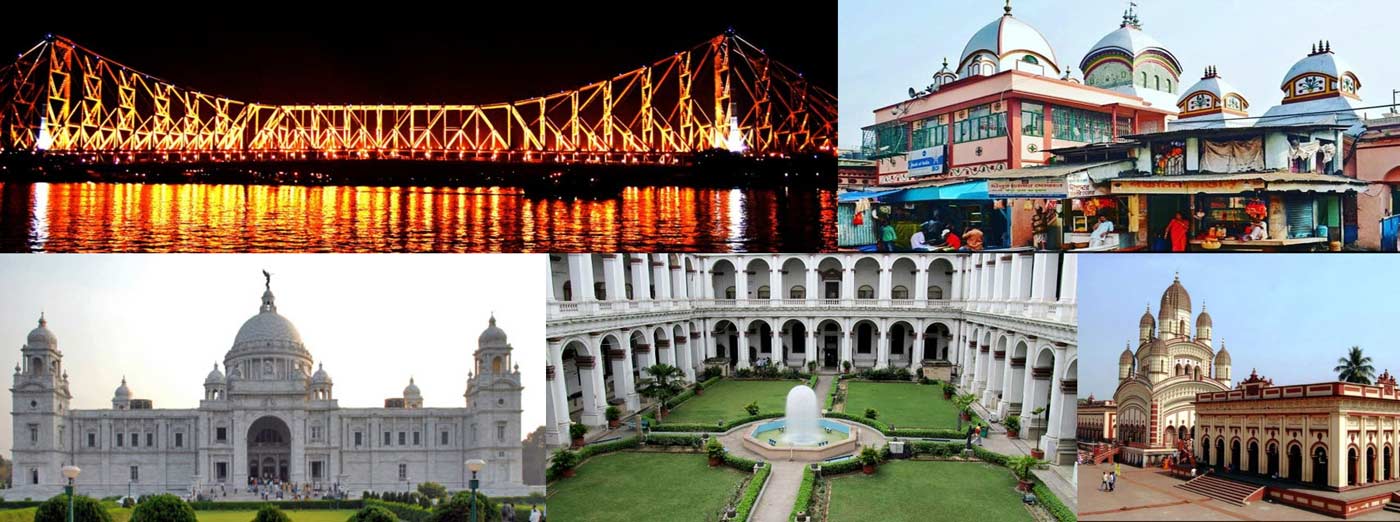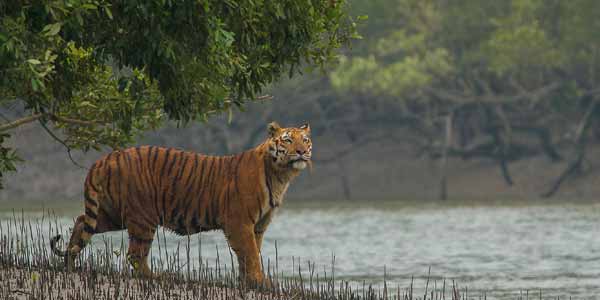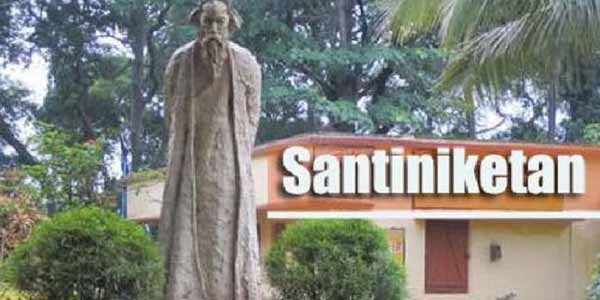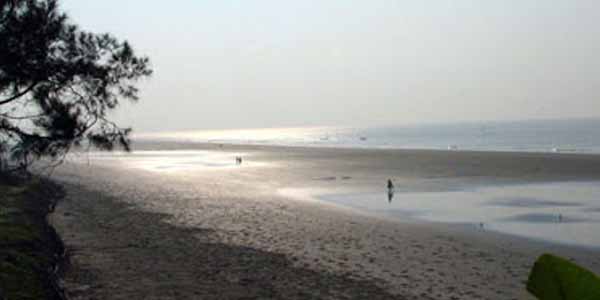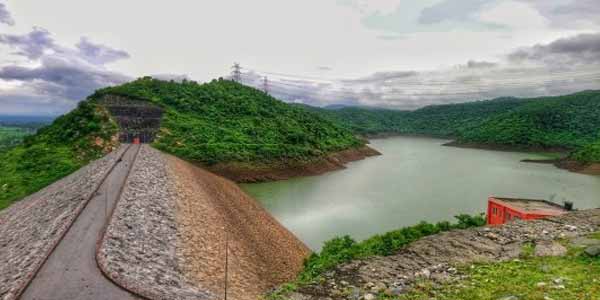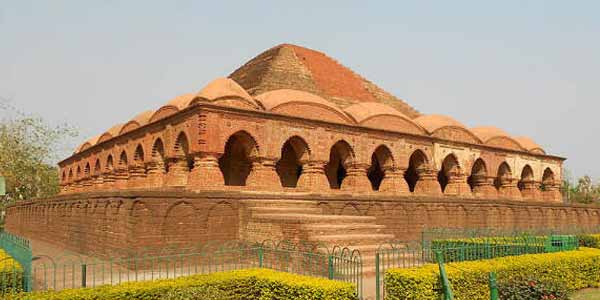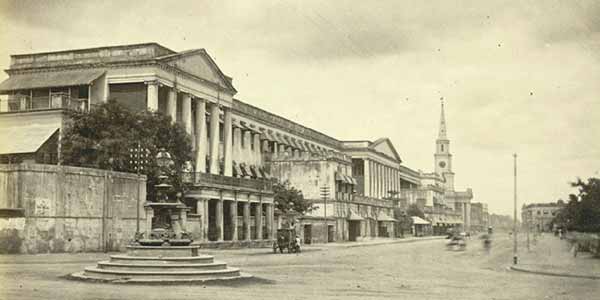
Shantiniketan
At Santiniketan the environment is always present in one"s consciousness. It becomes a part of one"s being here, more than anywhere else, which is why it grows on you and having lived here once it is difficult to forget. The Santiniketan environment has changed, grown and evolved with its community.
Santiniketan is situated at an elevation of 200 feet above sea-level giving it a slight bulge in an otherwise flat landscape. The ground slopes gradually to 100 feet above sea-level near the Ajay river about 3 miles to the south and the Kopai stream some 2 miles to the north. The southern boundary of Santiniketan merges into a vast plain of rice fields. On its northern fringes were the khoai lands with deeply indented gullies caused by erosion over denuded land. The District Gazetteer of Birbhum records that in pre-British days, Birbhum had an extensive forest cover. Progressive denundation of forests played havoc with the porous laterite soil. During the hot months, fierce dust storms scattered the loose soil far and wide. During the rains heavy erosion took place as after every downpour water rushed through undulating land creating gullies and gorges in its relentless march.
In the middle of the 19th century, Maharshi Devendranath Tagore found solace and serenity in this barren land. He purchased the land and started the construction of a house rightaway. This house, named, Santiniketan, was built in the early 1860s; the name later came to denote the entire area. A beautiful garden was laid out on all sides of the house. The top-layer of gritty dry soil was removed and filled with rich soil brought from outside. Trees were planted for fruit and shade.
As a child, Rabindranath accompanied his father to Santiniketan and recalled, much later, in Reminiscences, Though I was yet a mere child my father did not place any restriction on my wanderings. In the hollows of the sandy soil the rain water had ploughed deep furrows, carving out miniature mountain ranges full of red gravel and pebbles of various shapes through which ran tiny streams, revealing the geography of Lilliput… I was never tired of roaming about among those miniature hills and dales in hopes of lighting on something never known before.
I was the Livingstone of this undiscovered land which looked as if seen through the wrong end of a telescope. Everything there, the dwarfed date palms, the scrubby wild plums and the stunted jambolans, was in keeping with the miniature mountain ranges, the little rivulet and the tiny fish I had discovered.
When, in 1901, Rabindranath started his Brahmacharyasrama, he found the asrama "flanked on the south by a sal avenue and an entrance gate covered by a canopy of Madhavi creepers. To the east was an orchard of mango trees. Towards the west were a few palmyra palm, jamun, casuarina and, here and there, some coconut palms. Standing on the north-western outskirt of the old asrama were the two ancient Chhatim trees." Rabindranath"s choice of Santiniketan for his school was definitely because of its environment. In "My School", he has written:
"I selected a beautiful place, far away from the contamination of town life, for I myself, in my young days, was brought up in that town in the heart of India, Calcutta, and all the time I had a sort of homesickness for some distant lane somewhere, where my heart, my soul, could have its true emancipation... I knew that the mind had its hunger for the ministrations of nature, mother-nature, and so I selected this spot where the sky is unobstructed to the verge of the horizon. There the mind could have its fearless freedom to create its own dreams and the seasons could come with all their colours and movements and beauty into the very heart of the human dwelling."
The celebration of seasons was always a feature in the asrama. These festivals came to be associated with the special culture of this institution and the introduction of traditional Indian forms and rituals in organising these festivals, including the decoration of the site, use of flowers, alpana, chanting of Vedic hymns and blowing of conch-shells gave them a new dimension, aesthetically attractive, intrinsically Indian yet totally secular. Rabindranath felt, it was necessary that an affinity be built between the students" minds and the flora and fauna of the asrama.
It was always the objective in Santiniketan that learning would be a part of life"s natural growth. The first step towards this objective was to establish in the child a sense of oneness with nature. A child has to be aware of his surroundings - the trees, birds and animals around him. The mind is deprived if one is indifferent to the world outside. Rabindranath said we concentrate on learning from books and neglect the knowledge that is freely available on all sides.
From the beginning, he wanted his students to be aware of their environment, be in communication with it, probe it, make experiments and collect data and specimens. And to guide them he wanted teachers who could go beyond book-learning, who were seekers themselves and who would find joy in the process of learning. In this context one might mention Tejeschandra Sen, who along with Jagadananda Roy, was one of the pioneering teachers of Nature Study in India. They were able to instill in children a love for and curiosity about the natural world. Lord Haldane, visiting Santiniketan in 1954 was much impressed with Tejeschandra" s method of teaching.
In the mid-fifties, to prevent further erosion by the khoai, soil embankments were raised which thereby created little lakes of moderate size. The bunding of the Mayurakshi river some distance on the north-west brought Santiniketan a branch of an irrigation canal which forms its northern boundary. Thus started, the greening of khoai brought about significant changes in the environment. An extensive forest has been created where deer graze.
However, Santiniketan today is a veritable botanists" paradise. Plants, trees, creepers and orchids from various parts of India and abroad have been made to flourish in this once semi-desert. Rabindranath himself took a deep interest in planting trees. He introduced the Vriksharopana, or tree-planting ceremony in 1928, popularising the concept. His son, Rathindranath, was a horticulturist by training and introduced a number of new trees and plants into Santiniketan. Fortunately, the Santiniketan community in general shares this interest in trees and gardening. The seasons are clearly marked in Santiniketan; one knows the end of one season and the beginning of the other with the sights and smell of blossoms in bloom.
One cannot write of the Santiniketan environment without mentioning Ramkinkar Baiz. His outdoor sculpture is a part of our environment, not meant to be exhibited in museums. Children grow up with them, treating them as much a part of the environment as the trees and sky. Made of locally available material, these sculptural pieces depict life in and around Santiniketan. The Santhal Family or the Call of the Mill are so integral to Santiniketan that they do not evoke the same emotions when seen in its bronze cast in the capital of India! When Sujata was placed in Sangit Bhavana by Ramkinkar, walking towards the Buddha, Nandalal Bose planted eucalyptus trees around it to accentuate its height and blend it in a natural scene.
In the paintings of Nandalal Bose and Binodebihari Mukhopadhyay, the Santiniketan landscape has been captured for posterity. Surendranath Kar, Nandalal Bose and Rathindranath Tagore were acutely aware of the environment and took great pains to design buildings and houses that would merge with its surroundings.
Kolkata Excursions
The city of Kolkata offers you lots of excursion opportunities. Not only does it provides you wonderful raw hills, but also offers you opportunities to explore exotic beaches and wonderful deltas in the vicinity. Apart from exotic natural excursions, there are so many historic places in the vicinity that it would really become difficult for you, as a tourist, to choose between these options. A few of the popular tourist places near Kolkata have been listed below. Go through them and pick the ones that you want to include in this visit.
 +91 9799050299
+91 9799050299 